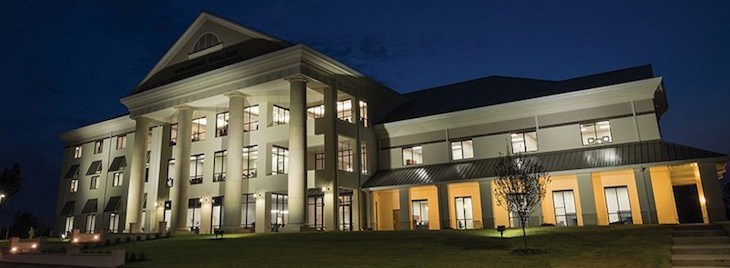Arkansas College of Osteopathic Medicine ready to welcome first class to Fort Smith
by April 17, 2017 2:23 pm 2,733 views

On July 31, 162 young men and women – average age of 24 – will populate classrooms and lecture halls of the Arkansas College of Osteopathic Medicine, bringing a building and idea to life that has been more than four years in the making.
The college is part of the Arkansas Colleges of Health Education (ACHE), created with primary support from The Degen Foundation, a Fort Smith-based philanthropy created with some of the revenue from the 2009 sale of Sparks Health System to then Naples, Fla.-based Health Management Associates. As of June 30, 2015, The Degen Foundation reported assets of $74.843 million, with $63.629 million restricted for ACHE. The college also has received a $14 million anonymous donation and has access to a $25 million low-interest loan.
Work began in February 2015 on the $32.4 million facility in east Fort Smith in the Chaffee Crossing area. The school is housed in the three story, 102,000-square-foot building, and a fully operational osteopathic college is expected to serve about 600 students. Each class will have 150 students.
The July 31 date is orientation for the first class of students, who were among more than 5,000 applicants. About 400 interviewed for the class, said ACHE President and CEO Kyle Parker. The class size begins at 162 because the Commission on Osteopathic College Accreditation (COCA), the accrediting body for osteopathic colleges, estimates an 8% dropout rate. Parker said COCA has granted provisional approval for the college to begin with its first class.
“We will remain provisional until we graduate the first class. All med schools, until they graduate their first class, are considered provisional,” Parker told Talk Business & Politics.
Parker also provided some demographic data on members of the first class.
• The average age is 24.
• Student gender is 54% male and 46% female.
• Ethnicity – of those who reported – is 65% white, 25% Asian, 8% mixed race, 5% hispanic, 4% American Indian, and 4% African American.
• 21% of the students are the first generation to pursue a higher education degree.
The tuition is $43,000 a year, which Parker said is the third least expensive osteopathic medical school among the 31 in the country.
“Bottom line: We are a bargain,” Parker said.
Faculty and staff are almost set, Parker said, with four faculty positions to be filled before July. He said the four openings will soon be filled, which will boost total faculty and staff to around 50. An estimated 14 more faculty will be hired when the second class comes on in 2018, Parker said.
An extensive network of clinics, hospitals and thousands of physicians around the state are already in place for the students when their residencies begin in the third year, Parker said. For example, the network includes 300 residency openings with community hospitals, 221 with rural primary care facilities, 418 in specialty surgery, and 559 in specialty internal medicine.
“And that list is growing almost every day,” Parker said.
Participating physicians are considered adjunct professors and are paid $500 a month per student, and hospitals are paid $1,000 per year per student.
Waiting for some of the students is the more than $6 million “house-look” student apartments built adjacent to the college. The 84-unit, 122-bed facility will include a swimming pool, exercise room, pavilion with fire pit, garden area and student study rooms. It will also be wired into the college so students may watch previous lectures and access other electronic data. Also, a student who may have the flu or some other contagion may view classes via video instead of running the risk of infecting classmates, Parker said.
The apartments, set to be completed in mid-July ahead of the orientation, were popular with incoming students.
“We sold out the residence in five days,” Parker said.
The 84-unit residence is the first of what could be three phases to provide student housing. A second phase is being planned for the second group of students who arrive in fall 2018. That phase may also include townhouse developments along with more apartments. A third phase could be all townhouse developments, Parker has said.
